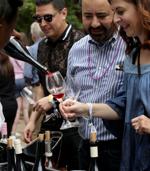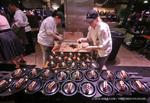The group of wines shown above represent the legacy cabernets personally selected by Austin Hope, a man who has spent the better part of two decades growing grapes and making memorable wine in Paso Robles.
This “legacy tasting,” welcome to all who visit, is the best representation of Austin Hope and Treana wines.
From left to right, say hello to the Austin Hope Paso Robles Signature Cabernet Sauvignon 2019 ($65), displaying a richness that has brought reward to the winery from Wine Enthusiast Magazine, which recently rated this wine as No. 7 in its list of the Top 100 Wines in the world for 2020.
Next up, the Treana 2019 ($32) was created as a cabernet to honor the three men who helped influence Hope’s path: Austin’s father, Chuck Hope, and his Uncle Paul, who instilled in him life lessons of perseverance and determination, while famous Napa Valley winemaker Chuck Wagner taught him the greatness of crafting world-class cabernet sauvignon.
The Quest 2018 ($27) is a new wine that expresses the potential and excitement of Paso Robles. It’s a cab sauv and cab franc red blend that showcases the luscious fruit-forward softness and depth of taste that finishes with a toasty vanilla finesse.
The Liberty School 2018 ($16) is a fundamental cabernet, a versatile wine with a deep crimson color and a wine with great value. Finally, Troublemaker (NV $20) shows a richness in color and texture with a scent of black pepper that produces a bold flavor from the dark fruit and a signature splash of blackberry cobbler, finishing with smooth, silky tannins.
Vittorio’s, in Carmel Valley, was the recent stage for the lineup of the Austin Hope Family Wines. It coincided with National Wine Day on May 25. The sold-out event featured three Treanas and the famed Austin Hope Cabernet, the just-released 2019. Vittorio’s owner Victor Magalhaes paired it with his ever-popular herb-crusted lamb chops, Yukon mashed potatoes and spring vegetable medley served au jus. The reaction to Hope wines went over the top.
Meanwhile the Paso Robles Wine Association, at its latest annual Wine Festival, held a virtual auction and called for exciting and attractive packages from its winery members. True to form, Austin Hope provided a package that included two magnum bottles of his award-winning signature cabernets with his signature on the wooden box and bottles.
Another box held six bottles of recent vintage 750 ml cabernet bottles. The market value was $900. The winning bid was nearly three times the market value.
Congratulations to the association for making such a smart choice for a bidding package. Learn more at austinhope.com.
Wine Bytes
- Happy hour is now back Monday-Friday, 3 to 6 p.m., at the bars of the three North County locations of Vigilucci’s: Cocina in Leucadia, Trattoria in Carlsbad and Seafood and Steakhouse in Carlsbad. Celebrate Dad on Sunday, June 20, and reserve a dinner at one of the Vigilucci’s restaurants at vigiluccis.com.
- A new “wow” trip event has been opened, the X Wine Railroad from Los Angeles to Santa Barbara, with multiple tasting trip dates of Saturday, June 19, from 9:15 a.m. to 9:45 p.m.; Sunday, July 11, from 9:15 a.m. to 9:45 p.m.; and Sunday, Aug. 8, from 9:15 a.m. to 9:45 p.m. Cost is $399 per person. It includes round-trip business-class seats, luxury ground transportation in Santa Barbara, a vineyard tour with vineyard-style lunch and lots more. For details, call 702-234-4124.
Frank Mangio is a renowned wine connoisseur certified by Wine Spectator. Reach him at [email protected]
June 01, 2021 at 11:35AM
https://ift.tt/2S3cCeG
Taste of Wine: Meetup with the Austin Hope Family Wines - Coast News
https://ift.tt/31lUVcw
Wine









:strip_exif(true):strip_icc(true):no_upscale(true):quality(65):fill(FFF)/cloudfront-us-east-1.images.arcpublishing.com/gmg/B2WWYRWTHNG6JLXCQLN5MOMIPI.png)






















